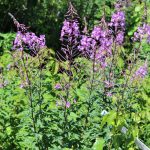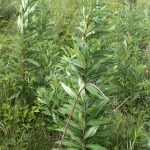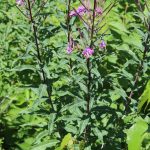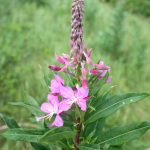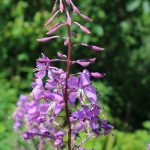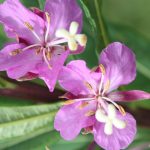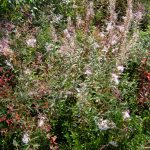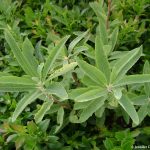Fireweed
Prepared by Jennifer L. D’Appollonio, Assistant Scientist, University of Maine, Orono, ME 04469. Updated April 2019.
Scientific name: Chamerion angustifolium (L.) Holub; old Epilobium angustifolium L.
Common name(s): fireweed, narrow-leaved fireweed, willow herb, great willow-herb, rosebay willowherb
Links: USDA PLANTS Profile , NPIN Profile, Go Botany
Images: (to see enlargements [PC]: click on image, then right click and choose “view image”)
- fireweed, leaves
- fireweed in flower, mid-July
- flowering progresses upward
- flower detail
- fruit, early September
- in prune blueberry field
Description:
-perennial
-herbaceous
-generally flowers late spring through August in ME
-reddish stems
-deep pink or rose colored flowers
- four spreading sepals
-may be confused with E. hirsutum or Lythrum salicaria; see left sidebar on Go Botany webpage
Habitat:
-widespread in northern climates
-disturbed areas
-burned or logged forests
-meadows
-moist areas
- not waterlogged
- lakes and bog
-known to be a natural colonizer of oil spill sites, acidic coal spills and mine waste
Agriculture:
-disperses by wind
-extensive root system
-wildlife foraging species
-produces nectar
-attracts pollinators
-can be a problem in perennial crops
Natural History:
-named after being found in burned areas
-can boil or steam the stems to eat
-can have a laxative effect
-used as an external medicine against eczema
Source(s):
Hansen, R.W., S.B. Hansen and E.A. Osgood. 1991. Reproductive phenologies of selected flowering plants in eastern Maine forests. ME Agric. Exp. Station Tech. Bull. 143. 17 pp.
Heinrich, B. 1976. Flowering phenologies: Bog, woodland, and disturbed habitats. Ecology. 57(5):890-899.
USDA. “FIREWEED Chamerion Angustifolium Holub.” Natural REsource Conservation Service- Plant Guide, United States Department of Agriculture, 2016, plants.usda.gov/plantguide/pdf/pg_chan9.pdf.

